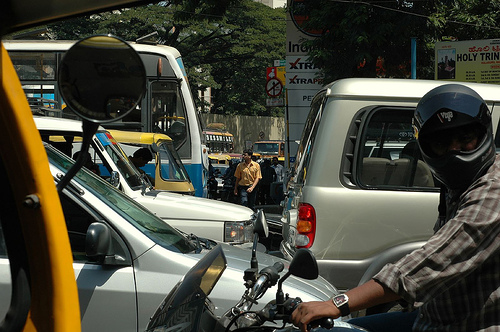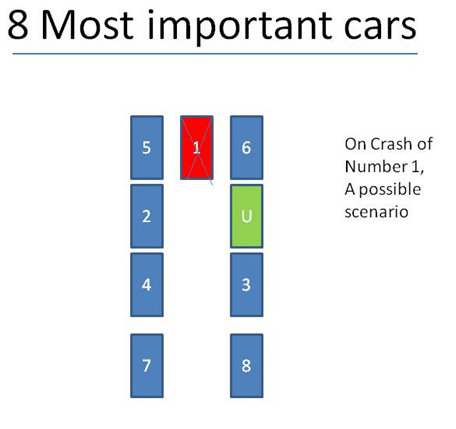Emerson’s Anand Iyer provides part three (part 1, part 2) of his Cloud I/O series sharing a primer on IO bubbles and central control units.
And since then the entire human race has been adding more asphalt, concrete, flyovers and other dumb infrastructure and from Boston to Beijing, we find that Humans are buying more cars and jamming up all these dumb infrastructure. Focus has not been on increasing throughput. Had we, as human’s added intelligence to this infrastructure 20 years ago, the situation today, would have been very different.
Solving Traffic problems of Boston to Beijing using some intuitive processing. While visiting Stuttgart’s Mercedes Benz museum, we were informed that in World War II-era Germany, the signaling and traffic signs were developed to a very high level. The roads till then were probably just some dust and asphalt or some cobbled stones laid along the way. By giving the many signboards and traffic personnel, the roads were made to communicate with people.
The 8 most important cars. When riding on the middle lane of a three-lane road, there is one car in front of you, which is the most important car in the world. Your life depends on this car. This car could be transmitting important information like its speed, destination (when it is likely to exit), when it is planning to overtake, tyre pressure, tyre temperature, braking alerts, and so on. Today your car practically knows nothing about this car. However, in the future with such information, you are probable as safe as riding a bicycle in your backyard.
The next most important cars are the ones to your left, right, front right, front left, rear, rear right and rear left. Maybe you could neglect the rear right and rear left for the time being.
Communicating roads. Now imagine that the roads have markers that tell the cars where they are and in which lane. And at regular intervals, the road itself picks up information from the cars plying on it. The roads know everything there is to know about the cars, the cars know everything there is to know about the road.
On the way from Dresden to Karlsruhe, it tells drivers (till R2D2’s or robotic arms replace drivers entirely), take the left (fast) lane a few kilometers before Stuttgart, as there is a huge volume going to or via Stuttgart tonight.
The system also tells cars that they could safely speed up, as there is no obstruction for a few miles up ahead. Will you lose the habit of looking over your shoulders and rear view mirrors? Well, most likely yes. Just like we don’t remember most phone numbers today.
When we look at it like a pipeline, then the road is intelligent and knows what particles are going through it, at places it picks and provides information, it builds a pattern based on this information. It has information as to what cars ply the road, their engine condition, tyre pressure and so on. Accidents are prevented before they are likely to happen.
A high tyre temperature or high pressure could ask the driver to slow down and move to slower lane or take a break. This is more like the central processing System (has processing as well as IO’s) which we can call Central Control Units, for the entire set of Cars (let’s call them Cloud I/O bubbles or IO bubbles for short). The cars are just bubbles that pass through it and as soon as one has passed it from any of its exit (it probably hands over sufficient advanced notice to the exiting road), it has no further interest in these bubbles.
Each road can have its own central processing unit (or several) that communicates with other road units.
The IO bubbles or cars themselves would monitor their condition and maybe of the eight most important cars in the world (to them). Their own information is shared as a bubble or packet of information with the central processing unit where they are. They drive at an optimum speed so as to take them to their destination, safely and in the best possible time.
The IO bubble has choices for example of taking the first Stuttgart exit or based on traffic conditions, the next Stuttgart exit. The different systems would drive the overall throughput of the traffic:
Number of cars driving on the road → Maximum,
Time taken to travel → Minimum, and
Safety → Maximum.
The existing infrastructure with such a system in place could serve many cities for decades without making roads 100-lane clogged parking lots.
Imagine a tyre burst at the most important car in the world (the one in front of you) and within milliseconds, you are directed to be in the right lane, the car to your right has probably already sped up and the one rear right has slowed down (or any other safer algorithm), the information travels at very high speed and everyone is already in the right lane, a accident team arrives faster than expected. Users could see later that part of the car is also on the right lane and everyone swerving right could intuitively tell the system to make new electronic line markers.
The possibilities of intuitive processing are many as long as there are humans on the steering wheel. Somebody could not follow instructions and be in the left lane till they reach the throat of the Stuttgart exit in the last example, or somebody going to school could come to know that their wife is also going to school to pick the kid up and make last minute decisions to change destinations.You could have several advanced algorithms at play here. There could be traffic safety processing, traffic decongestion processing, and traffic economy processing and so on.
Instructions to IO bubble. The central units could give several instructions to the IO bubble (the car). The Safety bubble could say, tyre pressure and temperature rise indicates a safe limit of max 150 kmph. The IO bubble has safety high limit as the highest priority and hence 150 becomes the high limit.
Fuel economy could be best in the range of 120 to 145. The economy processor would like to drive it to around 130 to 145 (130 being best). The time parameters would drive it to max speed possible that is 170 kmph.
The road tells the car that the max possible speed is 240 kmph. Anytime the system suggests a lower speed, then this becomes the upper speed limit for every car in that lane.
An intuitive algorithm in the system would work as follows, when late to work; priority is Safety, speed, economy. The car is driven at 145 kmph.
While going back from office, the speed would then be 130kmph (based on user choice).
Additional information from IO bubbles. In addition to car condition, the IO bubbles could pass on information to the road about road conditions (formation of sleet, snow level, oil spills, pothole formations and so on). This is similar to slugs passing or storing information about the insides of a pipeline and passing it on to the pipeline monitoring system or the slug manufacturer’s information system.
With 8 cars around the central car trying to do different things like exiting, speeding up, breakdowns, and so on, the Processing possibilities are many. Also, when a car leaves a highway and joins another, there could be several ways in which this exchange could be handled. One system passing information to another on the likely cars that would take the position of the most important cars on right and left side, how the two systems allow the car to pass from one road to another, The main highway could know how much throughput is possible on the city network at each interchange.
Having blogged in 2002 on the same and now seeing the first beginnings of the same (8 cars communicating and one lead car, leading the others in Germany, Boston going for some kind of traffic information system), it would be interesting to see in the future if such a IO cloud-bubble system becomes a reality (under any other trade name).






